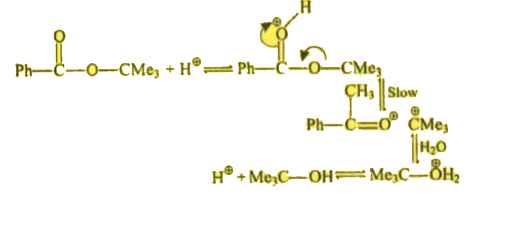Give the products formed on hydrolysis of (a) Al4C3 and (b) CaNCN.
To solve the question regarding the products formed on hydrolysis of Al4C3 and CaNCN, we will go through each compound step by step.
Step 1: Hydrolysis of Al4C3
1. Identify the compound: The first compound is Al4C3, which is aluminum carbide.
2. Reaction with water: When aluminum carbide reacts with water, it undergoes hydrolysis.
3. Write the reaction: The reaction can be represented as:
Al4C3+H2O→Al(OH)3+CH4
Here, aluminum hydroxide (Al(OH)3) and methane (CH4) are produced.
4. Balance the equation:
- On the reactant side, we have 4 aluminum atoms and 3 carbon atoms.
- To balance aluminum, we place a coefficient of 4 in front of Al(OH)3.
- To balance carbon, we place a coefficient of 3 in front of CH4.
- Now, we have to balance hydrogen. The total number of hydrogen atoms on the product side is 4×3+3×4=12+12=24. Therefore, we need 12 water molecules on the reactant side.
- The balanced equation is:
Al4C3+12H2O→4Al(OH)3+3CH4
Step 2: Hydrolysis of CaNCN
1. Identify the compound: The second compound is CaNCN, which is calcium cyanamide.
2. Reaction with water: Calcium cyanamide also undergoes hydrolysis when it reacts with water.
3. Write the reaction: The reaction can be represented as:
CaNCN+H2O→CaCO3+NH3
Here, calcium carbonate (CaCO3) and ammonia (NH3) are produced.
4. Balance the equation:
- In the reactant side, we have 2 nitrogen atoms from CaNCN.
- To balance nitrogen, we place a coefficient of 2 in front of NH3.
- The balanced equation is:
CaNCN+3H2O→CaCO3+2NH3
Final Products
- For Al4C3: The products are Al(OH)3 and CH4.
- For CaNCN: The products are CaCO3 and NH3.
Summary of Products:
1. Al4C3+12H2O→4Al(OH)3+3CH4
2. CaNCN+3H2O→CaCO3+2NH3
2. Reaction with water: When aluminum carbide reacts with water, it undergoes hydrolysis.
3. Write the reaction: The reaction can be represented as:
Al4C3+H2O→Al(OH)3+CH4
Here, aluminum hydroxide (Al(OH)3) and methane (CH4) are produced.
4. Balance the equation:
- On the reactant side, we have 4 aluminum atoms and 3 carbon atoms.
- To balance aluminum, we place a coefficient of 4 in front of Al(OH)3.
- To balance carbon, we place a coefficient of 3 in front of CH4.
- Now, we have to balance hydrogen. The total number of hydrogen atoms on the product side is 4×3+3×4=12+12=24. Therefore, we need 12 water molecules on the reactant side.
- The balanced equation is:
Al4C3+12H2O→4Al(OH)3+3CH4
2. Reaction with water: Calcium cyanamide also undergoes hydrolysis when it reacts with water.
3. Write the reaction: The reaction can be represented as:
CaNCN+H2O→CaCO3+NH3
Here, calcium carbonate (CaCO3) and ammonia (NH3) are produced.
4. Balance the equation:
- In the reactant side, we have 2 nitrogen atoms from CaNCN.
- To balance nitrogen, we place a coefficient of 2 in front of NH3.
- The balanced equation is:
CaNCN+3H2O→CaCO3+2NH3
- For CaNCN: The products are CaCO3 and NH3.
1. Al4C3+12H2O→4Al(OH)3+3CH4
2. CaNCN+3H2O→CaCO3+2NH3
Topper's Solved these Questions
- P-BLOCK GROUP 14 - CARBON FAMILYBOOK - CENGAGE CHEMISTRY ENGLISHCHAPTER - P-BLOCK GROUP 14 - CARBON FAMILYEXERCISE - Solved Examples
9 Videos
- P-BLOCK GROUP 14 - CARBON FAMILYBOOK - CENGAGE CHEMISTRY ENGLISHCHAPTER - P-BLOCK GROUP 14 - CARBON FAMILYEXERCISE - Ex (Subjective)
21 Videos
- P-BLOCK GROUP 13 - BORON FAMILYBOOK - CENGAGE CHEMISTRY ENGLISHCHAPTER - P-BLOCK GROUP 13 - BORON FAMILYEXERCISE - Exercise Archives (Subjecive)
9 Videos
- PERIODIC CLASSIFICATION OF ELEMENTS AND GENERAL INORGANIC CHEMISTRYBOOK - CENGAGE CHEMISTRY ENGLISHCHAPTER - PERIODIC CLASSIFICATION OF ELEMENTS AND GENERAL INORGANIC CHEMISTRYEXERCISE - Exercises (Archives )Subjective
4 Videos
Similar Questions
Knowledge Check
Hydrolysis of SiCl4 gives
ASi(OH)4BSiOCI2CSiO2DH2SiO4
Which of the following will give the racemised product on hydrolysis in presence of H2SO4 ?A B
B C
C D
D
BF3 on hydrolysis forms
View SolutionThe primary product of hydrolysis of CH3I is:
View SolutionGive hydrolysis product of CCl4.
View SolutionGive the products formed by the oxidation of hot KMnO4.
a. Cyclobutene b. 1− Methyl cyclobutene
c. 1,2− Dimethyl cyclobutene
View SolutionAlCl3 on hydrolysis gives
View SolutionCompound (A), C8H6NOBr, is optically active. Reduction of (A) gives (B) which reacts with nitrouos acid to form (C), dihydric alcohol. Benzene sulphonyl chloride reacts with (B) to give a product soluble in NaOH. Hydrolysis of (A) gives (D) which is an optically active acid. (A) does not give any precipitate with aqueous AgNO3 . Controlled oxidation of (A) gives monobromo benzoic acid. Compound (A) on reaction with Br2/Fe gives only one compound. Identify (A), (B), (C), and (D).
View Solution
